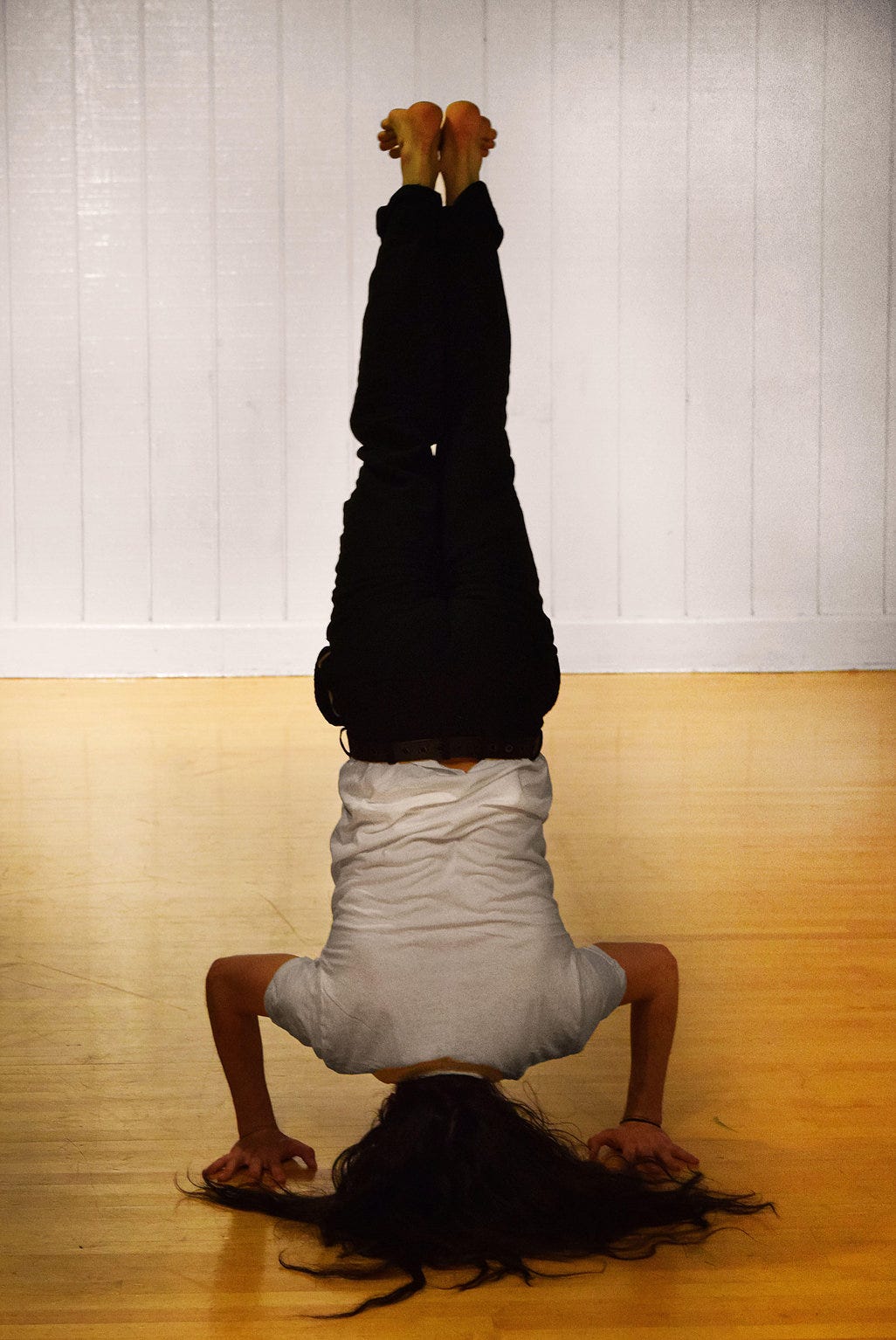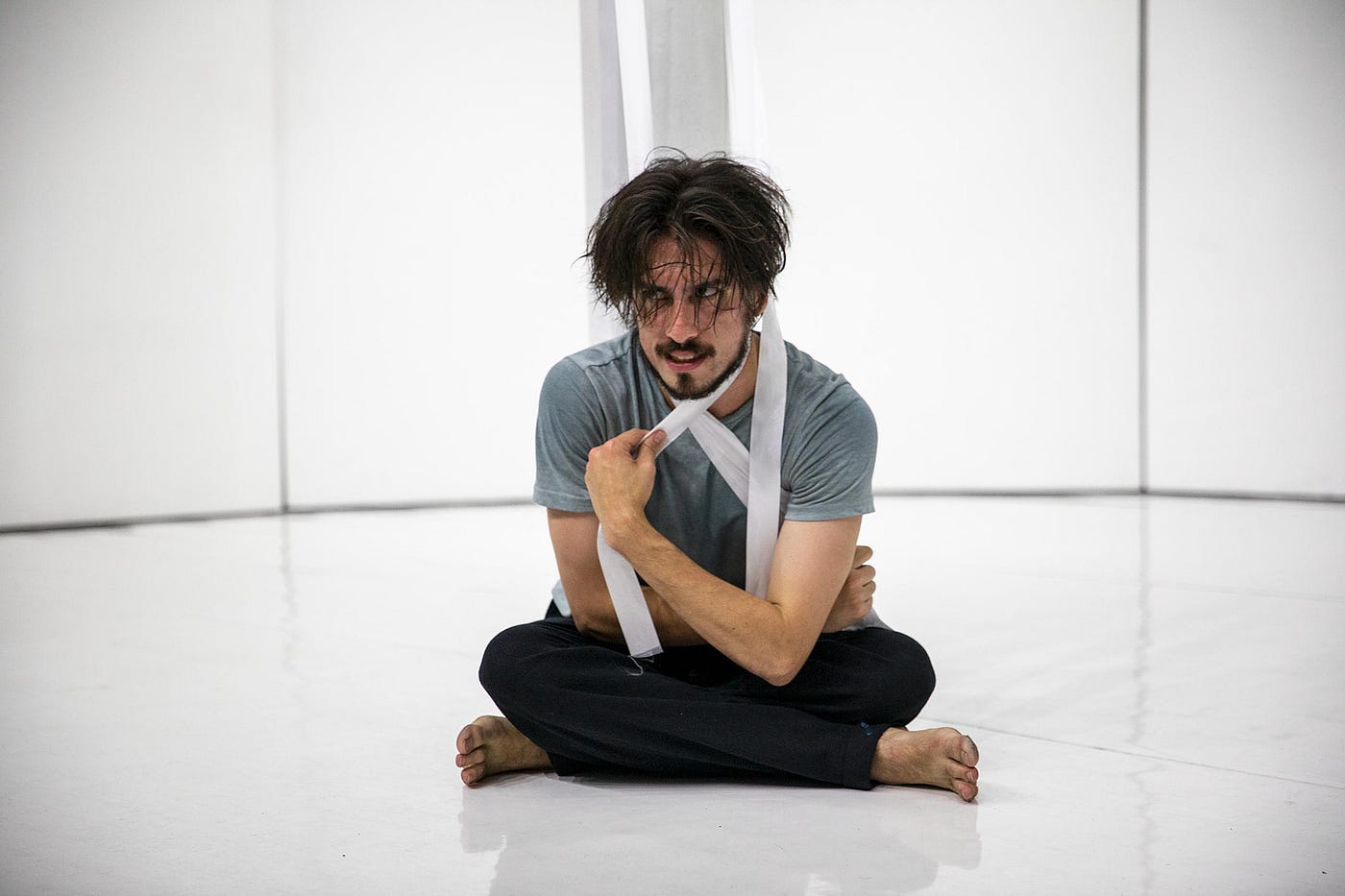
“An equal society should…”
“A just society should…”
“An open society should…”
Each unfinished statement is spoken by the dancer (Jonathan Matthews) in front of us. The audience is enthralled, watching the single figure contemplating each phrase before moving. He dances frantically yet poetically, gracefully moving around a stark white room, dressed in a clean, crisp white outfit, like an artist trapped inside a mental institute. The dancer continues to verbalize phrase after phrase, never completing them, only extorting them into the space.
Having been in New York City for a few years now, I have seen my fair share of contemporary and experimental dance work. Some of it has succeeded more than others, and some of the pieces have been downright odd or confusing. But none of them have come as close to the stereotyped notion of “experimental theatre” as Play! by This Is Not A Theatre Company, which specializes in creating non-traditional theatrical pieces, usually of a site-specific nature. Play! is their first big attempt at creating an interactive production.

Two-tiered rows of chairs line the walls as we enter the space. The whole piece is only 45 minutes long, a relatively short piece for NYC theatre audiences, and we are invited to sit and watch for the first 35 of them. In the room, there are two strange additions to the otherwise virginal space. On one side lies a large tome, which sits expectantly closed until it is called upon in the play. The rest of the room grows dim as the volume lights up with a single spotlight; the book, “speaking” through the speaker system around us, recites definitions of the term “play,” and the many types of play as defined by psychiatrist and play expert Stephen Brown: “spectator play,” “imaginative play,” “ritual play,” the list goes on.
In the other corner of the room, lies a small inflatable pool. The set design feels like the set up to a joke in poor taste, as one might find in a poorly-written Saturday Night Live skit. The tableau feels far too surreal to be taken seriously, but every moment of the piece is surprisingly taken with the utmost seriousness. Play! is determined to ensure that the audience learns something in its runtime.
Jonathan Matthews gives a stunning performance of his own choreography throughout this one-man (and one-book, and one-pool) show. His movement is effortless, and his monologue is impressively delivered throughout the show. He recites scientific study, asks rhetorical questions, questions the very nature of “play,” yet all the while he addresses no one in particular.
Get Edward Mylechreest’s stories in your inbox
Join Medium for free to get updates from this writer.
SubscribeSubscribe
The final ten minutes are where the interactivity of the piece actually kicks in. Having spoken at length about what “play” is, and what it can be, our performer invites audience members one by one to join him in the performance space (I am somewhat hesitant to say stage, although the “stage” has been set for this moment for quite some time). Here the audience member is compelled to follow the movements, and in doing so, to complete the unfinished phrases from the beginning of the show.
He says, “A fair society should…” and then the solo dance from earlier becomes a movement duet.
“An open society should….”
More audience members are brought from their chairs to join the action.
He continues and eventually, everyone is on stage, and at this point, it turns into a dance party.
Yes, really.
The audience is now part of the play, and invited to play we are. Streamers are handed around, bubbles are blown, and large inflatable balls are thrown around the space (perilously close to the expensive-looking lighting rig, I might add). The modern poet and philosopher of our times, Cyndi Lauper, plays through the speakers as we learn that in fact “girls, they just wanna have fun.”

The entire scene is bizarre and surreal. It can be best described as the end sequence of a film, where for no apparent reason, everything stops and breaks down into a party. It is lively, it is crowded, drinks are handed around, and I am left feeling confused. Everyone else may be having fun, but I feel like the kid invited to the party only because my mom knows your mom, and although the party itself may be fun, we’re not friends and I feel totally out of place.
Play! feels like the creation of highly intellectual, well-knowledged students of theatre, which is apt coming from This Is Not A Theatre Company which has an NYU drama professor and several PhD level artists and writers attached. For fans of both proscenium-based and non-proscenium experimental theatre, Play! may well have been an incredible performance. But for my own taste, it felt almost satirical of the genre, but without crossing over into parody. The audience around me seemed to enjoy the show, although the composition of the audience seemed to be somewhat biased towards the number of college students around the room.
The whole premise of the show relies upon the interactivity at the end — on this final act, the act of “play” from the participants. This interaction is literally the point of Play! And that is why I think I felt cheated coming away from the show. Having sat in a traditional theatre setting for the first three quarters of the performance, the moment where interaction actually began to happen felt cheap and lackluster for me.

To compare, I’ve loved my time inside worlds where I have played a supervillain trying to conquer the world (Rogues Gallery), or been unwittingly utilized in a TED talk that has gone haywire (Chaos Theory), or even participated remotely from a computer screen accessing the mainframe of a spaceship (Aluminum Cat). In each of these examples, play was a vital ingredient to the piece, and the work benefited greatly from it.
In Play! the moment of interaction felt like a surprise “twist” at the end of the show, rather than being a core component of the well-written and well-performed show. As much as play is the central theme of the piece, we as an audience were never really granted the opportunity to play, until the final moments of the show. At this point, to be invited to play felt more like a mandated requirement than an active choice. This is so frustrating as you can tell the creators have done their research and developed the piece entirely around the very concept of play, without letting us genuinely play ourselves. It is almost like the first three-quarters of the show was a setup to the joke, before we the audience became the punchline.
Play is truly wonderful, and a fantastic tool in the arsenal of immersive and particularly interactive work. It engages audiences in a way that traditional theatre can not — but it has to be used effectively within the show from the onset. When experiencing interactive theatre, I want to play with the creators, to be an equal participant, a suitable opponent, and a part of the game. In Play!, I felt more like a child’s plaything simply being taken along for the ride.
Play! continues through October 6 in New York City. Tickets are $20–25.
NoPro is a labor of love made possible by our generous Patreon backers. Join them today!
In addition to the No Proscenium web site, our podcast, and our newsletters, you can find NoPro on Twitter, Facebook, YouTube, Instagram, in the Facebook community Everything Immersive, and on our Slack forum.
Office facilities provided by Thymele Arts, in Los Angeles, CA.




















Discussion